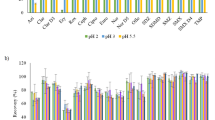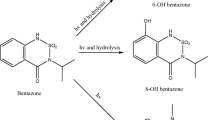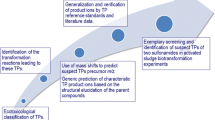Abstract
Etoposide susceptibility to microbiological breakdown was studied in a batch biotransformation system, in the presence or absence of artificial wastewater containing nutrients, salts and activated sludge at two concentration levels. The primary focus of the present study was to study etoposide transformation products by ultra-high performance liquid chromatography coupled to high-resolution hybrid quadrupole-Orbitrap tandem mass spectrometry (MS/MS). Data-dependent experiments combining full-scan MS data with product ion spectra were acquired to identify the molecular ions of etoposide transformation products, to propose the molecular formulae and to elucidate their chemical structures. Due to the complexity of the matrix, visual inspection of the chromatograms showed no clear differences between the controls and the treated samples. Therefore, the software package MZmine was used to facilitate the identification of the transformation products and speed up the data analysis. In total, we propose five transformation products; among them, four are described as etoposide transformation products for the first time. Even though the chemical structures of these new compounds cannot be confirmed due to the lack of standards, their molecular formulae can be used to target them in monitoring studies.






Similar content being viewed by others
References
Akhtar N, Talegaonkar S, Kishan Khar R, Jaggi M (2013) A validated stability-indicating LC method for estimation of etoposide in bulk and optimized self-nano emulsifying formulation: kinetics and stability effects. Saudi Pharm J 21:103–111
Beijnen JH, Holthuis JJM, Kerkdijk HG, van der Houwen OAGJ, Paalman ACA, Bult A, Underberg WJM (1988) Degradation kinetics of etoposide in aqueous solution. Int J Pharm 41:169–178
Chen C-L, Uckun FM (2000) Highly sensitive liquid chromatography-electrospray mass spectrometry (LC-MS) method for the determination of etoposide levels in human serum and plasma. J Chromatogr B 744:91–98
Donner E, Kosjek T, Qualmann S, Kusk KO, Heath E, Revitt DM, Ledin A, Andersen HR (2013) Ecotoxicity of carbamazepine and its UV photolysis transformation products. Sci Total Environ 443:870–876
Dow LW, Sinkule JA, Look T, Horvath A, Evans WE (1983) Comparative cytotoxic and cytokinetic effects of the epipodophyllotoxins 4′-demethylepipodophyllotoxin-9-(4,6-O-2-ethylidene-β-d-glucopyranoside) and 4′-demethylepipodophyllotoxin-9-(4,6-O-2-thenylidene-β-d-glucopyranoside) and their metabolites on human. Cancer Res 43:5699–5706
Ferrando-Climent L, Rodriguez-Mozaz S, Barceló D (2013) Development of a UPLC-MS/MS method for the determination of ten anticancer drugs in hospital and urban wastewaters, and its application for the screening of human metabolites assisted by information-dependent acquisition tool (IDA) in sewage samples. Anal Bioanal Chem 405:5937–52
Ferrando-Climent L, Rodriguez-Mozaz S, Barceló D (2014) Incidence of anticancer drugs in an aquatic urban system: from hospital effluents through urban wastewater to natural environment. Environ Pollut 193:216–223
Franquet-Griell H, Gómez-Canela C, Ventura F, Lacorte S (2015) Predicting concentrations of cytostatic drugs in sewage effluents and surface waters of Catalonia (NE Spain). Environ Res 138:161–172
Haim N, Nemec J, Roman J, Sinha BK (1987) In vitro metabolism of etoposide (VP-16-213) by liver microsomes and irreversible binding of reactive intermediates to microsomal proteins. Biochem Pharmacol 36:527–536
Hande KR (2008) Topoisomerase II inhibitors. Update Cancer Ther 3:13–26
Holthuis JJ, Postmus PE, Van Oort WJ, Hulshoff B, Verleun H, Sleijfer DT et al (1986) Pharmacokinetics of high dose etoposide (VP 16–213). Eur J Cancer Clin Oncol 22:1149–55
International Agency for Research on Cancer (IARC) (2012) http://monographs.iarc.fr/ENG/Classification/latest_classif.php/Volumes 1–114 (accessed 10th February 2016).
Kosjek T, Heath E, Kompare B (2007) Anal Bioanal Chem 387:1379–87
Kosjek T, Heath E (2011) Occurrence, fate and determination of cytostatic pharmaceuticals in the environment. TrAC, Trends Anal Chem 30:1065–87
Kosjek T, Perko S, Žigon D, Heath E (2013) Fluorouracil in the environment: analysis, occurrence, degradation and transformation. J Chromatogr A 1290:62–72
Liliemark E, Pettersson B, Peterson C, Liliemark J (1995) High-performance liquid chromatography with fluorimetric detection for monitoring of etoposide and its cis-isomer in plasma and leukaemic cells. J Chromatogr B: Biomedical Sciences and Applications 669:311–317
Martin J, Camacho-Munoz D, Santos JL, Aparicio I, Alonso E (2011) Simultaneous determination of a selected group of cytostatic drugs in water using high-performance liquid chromatography-triple-quadrupole mass spectrometry. J Sep Sci 34:3166–77
Negreira N, López de Alda M, Barceló D (2015a) Degradation of the cytostatic etoposide in chlorinated water by liquid chromatography coupled to quadrupole-Orbitrap mass spectrometry: identification and quantification of by-products in real water samples. Sci Total Environ 506–507:36–45
Negreira N, Mastroianni N, López de Alda M, Barceló D (2013) Multianalyte determination of 24 cytostatics and metabolites by liquid chromatography–electrospray–tandem mass spectrometry and study of their stability and optimum storage conditions in aqueous solution. Talanta 116:290–299
Negreira N, Regueiro J, Lopez de Alda M, Barcelo D (2015b) Degradation of the anticancer drug erlotinib during water chlorination: non-targeted approach for the identification of transformation products. Water Res 85:103–113
Pluskal T, Castillo S, Villar-Briones A, Orešič M (2010) MZmine 2: modular framework for processing, visualizing, and analyzing mass spectrometry-based molecular profile data. BMC Bioinformatics 11:395
Süzer Ö. University of Istanbul. http://www.ctf.edu.tr/farma/onersuzer/pdf/ing/05_Dysinfectant.pdf (accessed 25th December 2013).
Vairamani M, Suma K, Kamal A, Gayatari NL (1996) Mass spectral study of etoposide. Rapid Commun Mass Sp 10:817–820
Yin J, Shao B, Zhang J, Li (2010) A preliminary study on the occurrence of cytostatic drugs in hospital effluents in Beijing, China. Bull Environ Contam Toxicol 84:39–45
Zhao L, Tian X, Fan P-C, Zhan Y-J, Shen D-W, Jin Y (2008) Separation, determination and identification of the diastereoisomers of podophyllotoxin and its esters by high-performance liquid chromatography/tandem mass spectrometry. J Chromatogr A 1210:168–177
Zounková R, Odráška P, Doležalová L, Hilscherová K, Maršálek B, Bláha L (2007) Ecotoxicity and genotoxicity assessment of cytostatic pharmaceuticals. Environ Toxicol Chem 26:2208–2214
Acknowledgments
The financial support of the European Community’s Seventh Framework Programme (FP7/2007–2013), grant agreement no. 265264: CytoThreat (Fate and effects of cytostatic pharmaceuticals in the environment and the identification of biomarkers for improved risk assessment on environmental exposure) and 603437: SOLUTIONS (Solutions for present and future emerging pollutants in land and water resources management), the Slovenian Research Agency programme P1-0143 (Cycling of substances in the environment, mass balances, modelling of environmental processes and risk assessment), J1-6744 (Development of Molecularly Imprinted Polymers and their application in environmental and bio-analysis) and L1-5457 Pharmaceutical and personal care product residues in the environment: occurrence, sources, treatment and effects), and the Generalitat de Catalunya (Consolidated Research Groups “2014 SGR 418—Water and Soil Quality Unit” and 2014 SGR 291—ICRA) are acknowledged. Merck is also acknowledged for the gift of LC columns.
Author information
Authors and Affiliations
Corresponding author
Additional information
Responsible editor: Philippe Garrigues
Electronic supplementary material
Below is the link to the electronic supplementary material.
ESM 1
(DOCX 753 kb)
Rights and permissions
About this article
Cite this article
Kosjek, T., Negreira, N., Heath, E. et al. Biodegradability of the anticancer drug etoposide and identification of the transformation products. Environ Sci Pollut Res 23, 14706–14717 (2016). https://doi.org/10.1007/s11356-016-6889-5
Received:
Accepted:
Published:
Issue Date:
DOI: https://doi.org/10.1007/s11356-016-6889-5




